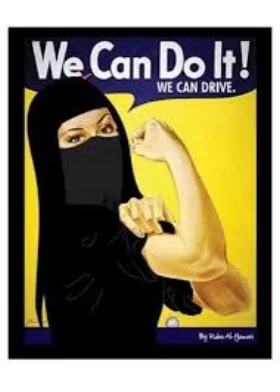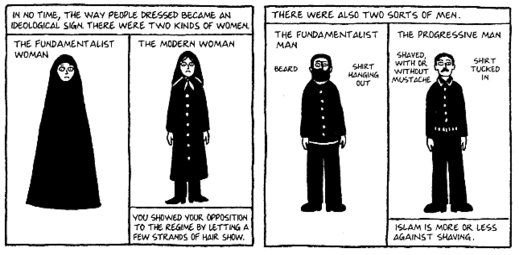writer: Anshu N. Chatterjee
A new battleground appears to have opened up in Saudi and Iranian regimes' historical competition for power. The two countries’ hostile involvement in Yemen, Lebanon, Syria and Palestine is well known; yet, at the margins of international politics and society, the two regimes are engaged in another type of competition which is not so obvious. And some courageous women are taking advantage of this new frontline.
Historically, the display of male authority has often played out on the female body in these two countries more obviously than in other parts of the world. Neither Iranian nor Saudi women are allowed to partake is several activities their counterparts in other parts of the world are commonly engaged in, such as walking in public with their ankles exposed. But the new international and economic reality appears to have produced a surprising new space for the continuous struggle between the two nations.
This story began about a year ago, when Saudi Arabia's new Crown Prince, Mohammed Bin Salman, ushered in a modest liberalizing change by allowing women to drive and attend sports events in stadiums. Until then, Saudis were lagging severely behind rest of the world in the rights for women, including Iran; the restrictions on Saudi women prevented them from engaging in simple acts such as driving to a grocery store. The Prince's generosity also provided a civic space for discussions on why women need to wear hijab or need a male guardian. As a result, he is hailed as the long awaited face of liberalism in the region.
From Japan Times...
Why is he doing this? The answer lies in Saudi Arabia’s changing political and economic relationship with the international community. Saudi Arabia’s western allies have increasingly critiqued Saudi for encouraging Islamic radicalism since 9/11. These allies are critical for the country because they not only indirectly fund the regime through their purchase of petrol, they also sell it weapons and support its causes in Yemen, Iraq, and against Iran. The U.S. came to its rescue in 1990 against Saddam and more recently sold Saudis an array of weapons in the country’s pursuit of removing Iran-backed Houthis in Yemen. In a parallel social universe, the West has also made the suppression of Muslim women as a cause celebre for various reasons. Some of this is simply due to racist views of non-western societies, since these countries criticize patriarchy in the Muslim world while ignoring it at home. Now the Prince is out to illustrate that he heads a moderating regime; easing up on women sends a clear signal of his intentions.
Challenges to the Saudi economy also loom ahead. Saudi citizenry has lived off revenues from oil sales for decades. But now due to expected shortages in the future, the government must collect taxes and legitimize itself through other means. Along with liberalizing moves towards women to please the west, the state also must diversify its industry. For that to succeed, it needs markets and partners in the West and maybe China too. Clearly, the state is running out of throw-around money even though MBS does continue to purchase luxury items indiscriminately. And, since women make up half of the country, he will do well by getting their support. They are also an important labor resource for the future.
And then there is its competition with Iran. The Iranian Islamic regime has shown its capacity to survive, has developed a nuclear program, and contains significant oil reserves. All of this while regaining some legitimacy in the eyes of the West: particularly among the Europeans. Iran supports rebels in Palestine, Houthis in Yemen, and provides relatively more rights to women. The Iranian revolution in 1979 legally placed women behind a chador and the majority of the citizenry under some restriction or the other. Yet, Iranian women are allowed to drive to work and smoke hookahs in bars without a male guardian. They engage in a range of public activities unavailable to Saudi women while wearing a head covering of some sort that ranges from a long scarf in a more liberal Shiraz to a full chador in the conservative Qom or Tehran. But they are not allowed to attend football games; allowing such attendance was a superior chess move by the Saudi prince this year.
Interestingly, the Saudi move may have triggered women in Iran to demand further rights. There is a developing movement - 27 women have thrown their head scarfs off in public and have been arrested - a movement initiated by an act of removal of a scarf by girl at Enghelab Street in December 2017. Women have pursued equal rights in Iran for a long time, but since 2003, some saw Rouhani’s election as the opening of a less conservative regime. The Saudi move also presented an opportunity for Iranian women who saw Saudi moderating moves following a protest in Riyadh. The Iranian Shia state has repeatedly claimed that they are more egalitarian than their Sunni brothers: the last thing they need is to draw attention to their human rights problems when things are going well. So, while the state arrested some women, it also reduced or forgave jail sentences.
But women will do well to remember that these moderating moves by such patriarchies continue to be influenced by what is external to them. No harm in trying to get the world’s attention though. This is an opportunity that needs to be taken advantage of and small victories need to be celebrated. Salute to women in these regions that recognize it and are pushing the envelope.
From Persopolis, the comic book.



